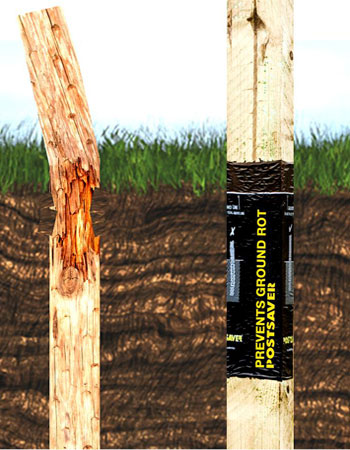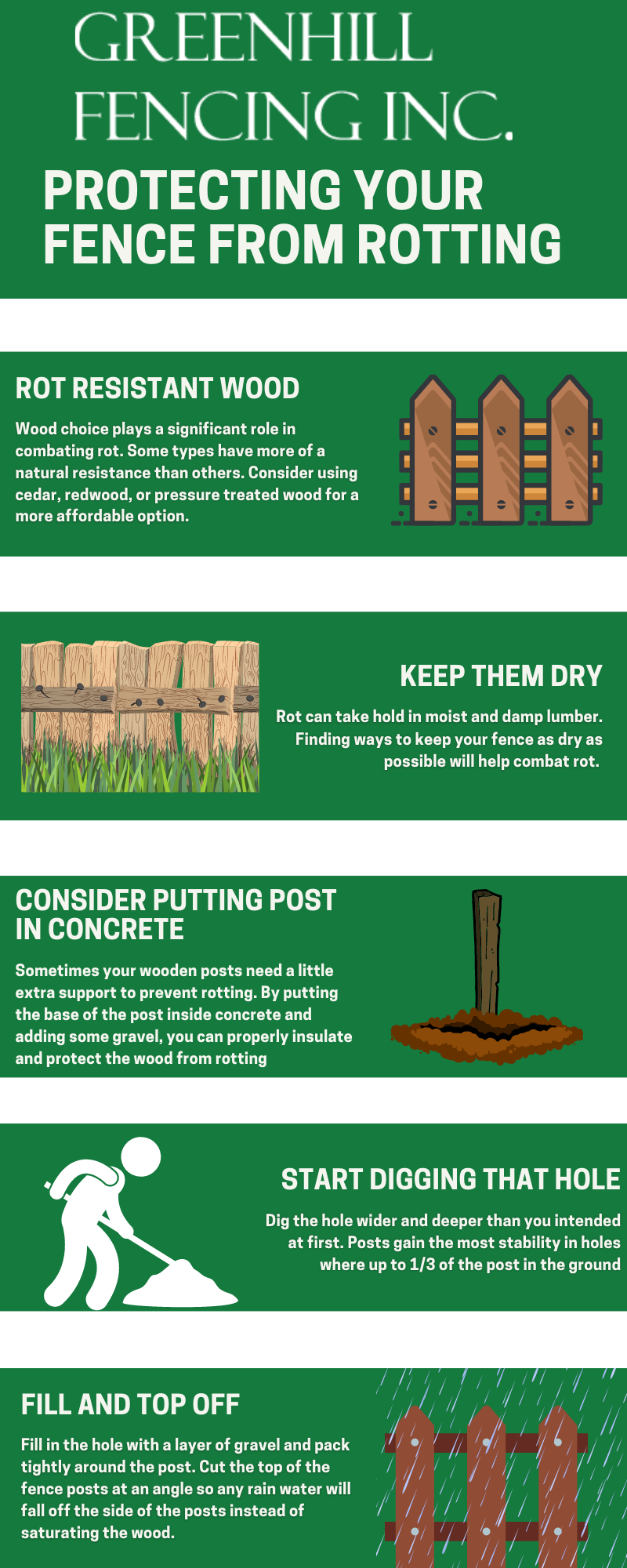To prevent wood fence posts from rotting, use pressure-treated lumber or apply a wood preservative directly to the posts. Wood fence posts are susceptible to rotting due to exposure to moisture and soil.
Rot can weaken the posts and compromise the stability of the entire fence. To prevent this, it's important to take proactive measures to protect the wood from moisture and decay. We will explore effective methods for preventing wood fence posts from rotting, including using pressure-treated lumber, applying wood preservatives, and practicing proper installation techniques.
By implementing these strategies, you can ensure the longevity of your wood fence and maintain its structural integrity for years to come. Implementing these preventive measures will save you time, money, and effort in the long run while keeping your wood fence posts in excellent condition.
Choosing The Right Type Of Wood
When it comes to preventing wood fence posts from rotting, choosing the right type of wood is crucial. The quality of the wood and its resistance to rot will determine the durability and lifespan of your fence. Let's explore some key factors to consider when selecting the appropriate wood for your fence posts.
Quality Matters
Quality plays a significant role in the longevity of your wood fence posts. Opting for high-quality, well-treated wood will ensure better resistance against rot and decay. Here are a few essential tips to keep in mind:
- Choose lumber that is labeled as "ground contact" or "use class 4." These classifications indicate that the wood is specifically treated to withstand exposure to moisture and soil.
- Check for any visible signs of decay or damage on the wood. It's crucial to start with healthy wood to prevent future issues.
- Inspect the wood for splinters, cracks, or knots. Smooth, knot-free lumber is less prone to water infiltration, ultimately reducing the risk of rot.
Rot-resistant Options
To ensure the best possible protection against rot, consider using rot-resistant wood species. These types of wood naturally contain properties that make them less susceptible to decay. Here are some popular rot-resistant options:
| Wood Species | Benefits |
|---|---|
| Cedar | Cedar wood contains natural oils that act as preservatives, making it highly resistant to rot, decay, and insect damage. It's also known for its appealing appearance and pleasant aroma. |
| Redwood | Redwood possesses natural tannins and oils that enhance its resistance to decay and insect infestation. It also boasts an attractive, rich color that adds beauty to your fence. |
| Pressure-Treated Pine | Pressure-treated pine is a cost-effective option that undergoes a chemical treatment process to repel moisture, insects, and fungi. It offers optimal durability for a long-lasting fence. |
By selecting rot-resistant wood species such as cedar, redwood, or pressure-treated pine, you can significantly reduce the chances of your fence posts rotting and enhance the overall lifespan of your fence.

Credit: wealdfencing.co.uk
Applying Protective Coatings
Protecting wood fence posts from rotting is crucial to prolong the life of your fence and minimize maintenance costs. One effective method for preventing rot is by applying protective coatings. These coatings act as a barrier against moisture and decay, helping to preserve the integrity of the wood.
Sealants And Waterproofing Products
Sealants and waterproofing products create a protective layer on the surface of the wood, preventing water from seeping into the pores and causing decay. Silicone-based sealants are particularly effective in repelling moisture and preventing rot. Applying a high-quality sealant or waterproofing product to the entire surface of the wood fence posts can significantly extend their lifespan.
Priming And Painting
Priming and painting wood fence posts not only enhance their visual appeal but also provide a protective barrier against moisture and decay. Before painting, it's essential to apply a primer specifically designed for exterior wood. This primer helps seal the wood and improves adhesion of the paint. Choose a high-quality exterior paint that contains fungicides and UV inhibitors to provide long-lasting protection against rot.
Proper Installation Techniques
Proper installation techniques are vital in preventing wood fence posts from rotting. By following recommended methods, you can ensure the longevity and stability of your fence. Two critical considerations for proper installation techniques include concrete footings and keeping posts elevated.
Concrete Footings
When setting up your wood fence, using concrete footings is a crucial step to prevent wood rot. Concrete footings provide a stable base for the posts, minimizing ground contact to safeguard against moisture. It also prevents soil from coming into direct contact with the wood, reducing the risk of decay.
Keeping Posts Elevated
Elevating the fence posts is a significant preventive measure. By keeping the posts elevated, you reduce the risk of water pooling around the base, helping to mitigate rot. Opt for metal post anchors or using crushed gravel to elevate the posts, enhancing their longevity and durability.
Regular Maintenance And Inspections
Regular maintenance and inspections are crucial for preventing wood fence posts from rotting. By incorporating a routine maintenance schedule and conducting thorough inspections, you can identify and address any issues before they worsen, prolonging the lifespan of your wood fence.
Cleaning And Removing Debris
To begin, it's important to regularly clean your wood fence posts to eliminate debris and moisture buildup. Use a soft brush or cloth to gently remove dirt, leaves, and other organic matter that could potentially trap moisture against the wood surface. Dispose of any debris properly.
In addition to cleaning, it's beneficial to remove any vegetation or ivy that might be growing near the fence. These plants can retain moisture against the wood, accelerating the rotting process. By clearing away these potential hazards, you create a barrier that promotes airflow and reduces the risk of rot.
Detecting Early Signs Of Rot
Regularly inspect your wood fence posts for early signs of rot. By catching any problems early on, you can take prompt action to prevent further damage. Look for discoloration, soft spots, or an unpleasant musty odor, as these are common signs of rot.
Pay special attention to areas where the wood is in direct contact with the ground or where water might accumulate, such as at the base of the fence posts. These areas are more prone to rotting. If you notice any signs of decay, it's essential to promptly address the issue to prevent the spread of rot.
Methods of addressing rot include:
- Using a chisel or other suitable tool to remove the affected wood.
- Applying a wood filler or epoxy to stabilize the damaged area.
- Treating the wood with a fungicidal solution to stop the rot from spreading.
| Important Points: |
|---|
| Regularly clean your wood fence posts to remove debris and moisture. |
| Clear away any vegetation or ivy that can retain moisture against the wood. |
| Inspect the wood for early signs of rot, such as discoloration and soft spots. |
| Promptly address any rot by removing affected wood, using fillers or epoxies, or applying fungicidal solutions. |
Alternative Materials And Techniques
When it comes to preventing wood fence posts from rotting, considering alternative materials and techniques is a wise choice. By exploring options such as composite and vinyl materials, as well as metal post supports, you can ensure the longevity and durability of your fence. Let's dive into these options to understand how they can help to prevent rotting and prolong the life of your fence.
Composite And Vinyl Options
Composite and vinyl materials offer a fantastic alternative to traditional wood fence posts. These materials are designed to be moisture-resistant, which makes them highly resistant to rotting. Their durability and low maintenance requirements are also highly appealing to homeowners.
| Advantages of Composite and Vinyl Options: |
|---|
|
By opting for composite or vinyl fence posts, you can protect your investment and enjoy a beautiful fence that stands the test of time.
Metal Post Supports
Another effective technique for preventing wood fence posts from rotting is to use metal post supports. These supports enhance the stability of the posts and create a barrier between the wood and the ground, minimizing exposure to moisture.
| Benefits of Metal Post Supports: |
|---|
|
By incorporating metal post supports into your fence installation, you can ensure that your wood posts remain stable, dry, and free from rot for many years to come.

Credit: www.greenhillfencing.com
Frequently Asked Questions Of How To Prevent Wood Fence Posts From Rotting
How Can I Prevent Wood Fence Posts From Rotting?
To prevent wood fence posts from rotting, make sure to choose pressure-treated wood, apply a waterproof sealant, and keep the posts away from standing water.
How Often Should I Inspect My Wood Fence Posts For Rot?
Inspect your wood fence posts for rot at least once a year to catch any signs early and take necessary actions to prevent further damage.
What Are The Signs That My Wood Fence Posts Are Rotting?
Signs of rotting wood fence posts include soft or spongy spots, discoloration, cracks, and excessive moisture around the base.
Can I Repair A Rotted Wood Fence Post Or Should I Replace It?
If the rot is minor, you may be able to repair a wood fence post by applying a wood filler. However, if the rot is extensive, it's best to replace the post to ensure the stability and safety of your fence.
Conclusion
Protecting your wood fence posts from rotting is essential to ensure its durability and longevity. By following these simple tips, such as using pressure-treated wood, applying a protective sealant, and maintaining proper drainage, you can prevent your fence posts from succumbing to rot.
Regular inspections and prompt repairs will also help preserve the integrity of your fence. By implementing these preventative measures, you can enjoy a sturdy and beautiful wood fence for years to come.

0 Comments